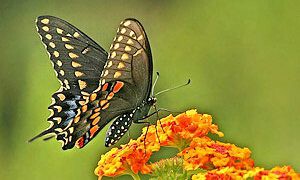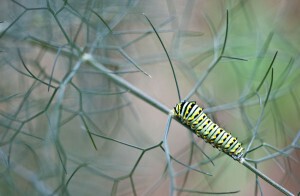In the warm summer months it’s easy to tell the gardens that are the serious butterfly attractors. Where butterflies abound, it’s usually not by chance. They’re attracted by specific elements, all which can easily be added to any garden.

Butterflies need nectar throughout their life but adults feed primarily in sunny areas. They are most attracted to brightly colored flowers in hues of red, orange, yellow, purple and pink for this food source. Flowers with flat tops make good landing pads and short flower tubes make easier access to nectar. Good tried and true examples of sun-loving favorite flowers include Zinnia, Verbena, Black-eyed Susan, Purple Coneflower, Butterfly Bush and Lantana.
To create an even more inviting environment, provide a water source in the form of a shallow mud puddle or ‘muddle’. A saucer from a flowerpot or any shallow container works well. A flat rock placed within the saucer provides a convenient spot for butterflies to land and rest as they take up water, minerals and nutrients. Muddles are easy to make. In addition to the container and stone, add some sand, mushroom compost and water to create a slurry mix.
Butterflies also need to warm their wings before taking flight. To accommodate them, flat stones are good for absorbing heat. They can be located in the garden as a great place for butterflies to rest and bask in the sun’s rays before their busy day begins.
Attracting butterflies is only half the pleasure. Encourage them to stay and lay eggs for a future generation. Include in the garden or landscape host specific plants that serve as food for the butterfly larvae. Butterflies will almost always lay their eggs on plants preferred by that caterpillar. However, it’s important to do your research and know what host plants are preferred by that caterpillar larva. They usually have a strong preference to just a few specific plants.
Some popular host plant choices include parsley, dill, fennel, Queen Anne’s Lace, passion vine, ilkweed and many grasses. Just keep in mind as the caterpillar matures, it will be munching on the host plant as its food source. Be sure to be aware of this and not confuse the damage as a problem caused by an undesirable pest. Therefore, avoid the use of any insecticides or pesticides, as these will likely kill the larvae and butterflies.
Within a few weeks, a chrysalis will form and the larvae will develop into the next generation of butterflies to not only adorn your garden, but perform important pollinating duties as well.
Although there are more than 700 species of butterflies in North America, ranging in size from barely a half-inch to nearly 10 inches, most have a short life span averaging only 10-20 days. The more we can do to attract and keep them in our gardens, the more enjoyment we’ll have from these beautiful creatures.